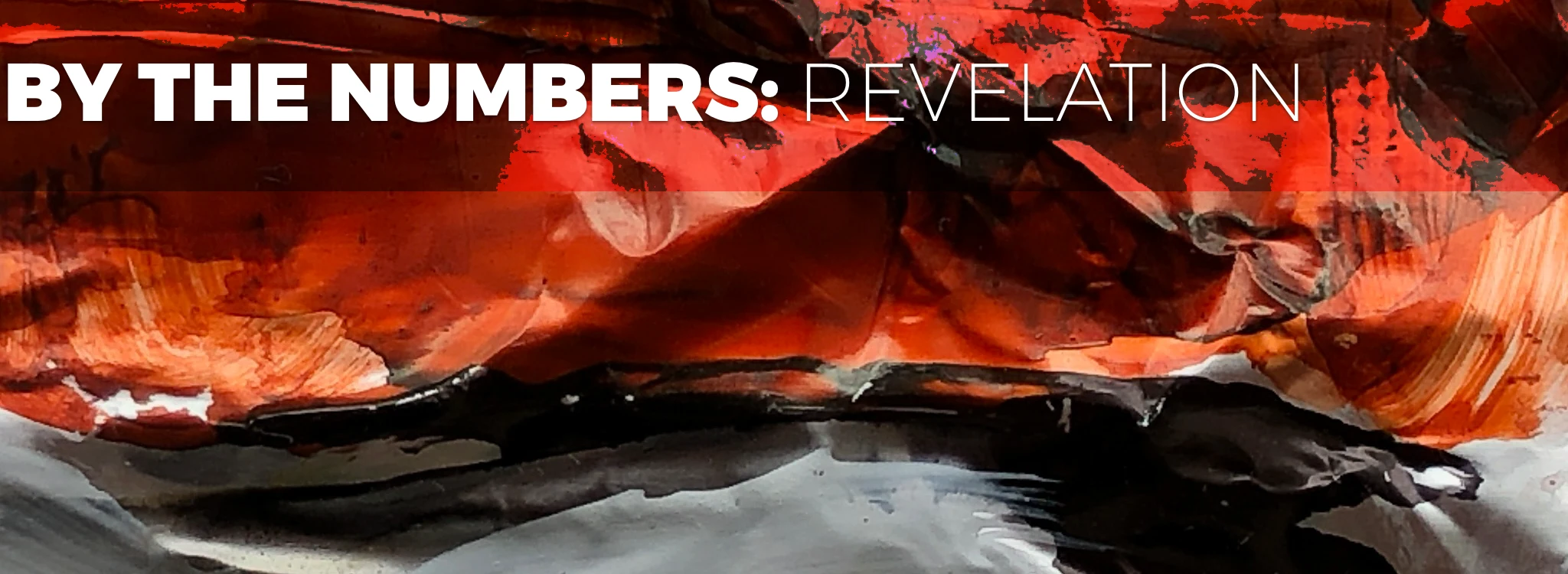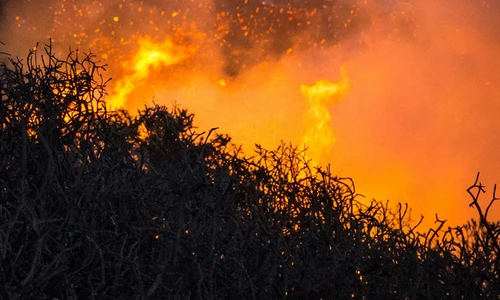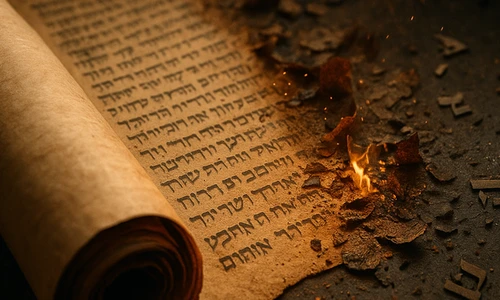Revelation by the Numbers: 0–1
This post is part of the series “Revelation by the Numbers”
-
Understanding the Sevens in Revelation
-
Revelation by the Numbers: 0–1 👈 you are here
-
Revelation by the Numbers: 2–4
-
Revelation by the Numbers: 5–24
-
Revelation by the Numbers: 30–1,260
-
Revelation by the Numbers: 1,600+
Introduction
While I was compiling a list of the sevens in Revelation, I couldn’t help but notice just how many numbers John uses. I mean, a lot of them are sevens. But there are plenty that aren’t, too, and I just felt bad leaving the rest of them out.
So here are all the other numbers John of Patmos saw in his vision or used in his book:
- 0
- 1/10, 1/4, 1/3
- 1, 2, 3, 3.5, 4, 5, 6, 8, 10, 12, 24, 30, 42
- 100, 144, 666
- 1,000, 1,260, 1,600
- 12,000
- 144,000
- 100,000,000, 200,000,000
- and “an innumerable multitude” for good measure.
He uses some of these repeatedly (1/3 is surprisingly common), and some only once (those 9-digit numbers at the end, for example). You can catch a few more interesting patterns right off the bat, before you even know what the numbers stand for.
- There are 3 fractions1, plus a decimal at 3.5.
- Somehow we have 0, 1, 2, 3, 4, 5, 6, 7, 8, and 10, but not 9.
- Twelve shows up an awful lot: 12, 24, 144… even 1,260 is divisible by 12.
- Despite his use of both 100,000,000 and 200,000,000, John still sees a crowd he can’t count. That crowd must be massive.
Because numbers are so prevalent in Revelation—perhaps even more than in any book (except Numbers, of course)—I’ve divided this exploration into 5 subparts, not including the original post on sevens, each of which should take about 15 minutes to read if you go straight through. Or feel free to jump around to numbers that interest you.
All right. Let’s dig in.
Note on Interpreting Revelation
Our first number: 2,000. That’s how many years theologians have been disagreeing wildly about the meaning of the visions in Revelation, primarily based on a disagreement about the timeline of the events described. Briefly, here are the major views:
- Preterist: The events of Revelation are mostly ancient, describing events leading up to the destruction of Jerusalem in 70 AD.
- Historicist: The events of Revelation are mostly historical, describing events throughout human history up to and including the present.
- Futurist: The events of Revelation are mostly future, describing events at some unknown time ahead.
- Idealist: The events of Revelation are mostly symbolic, taking place again and again at various times and on various scales throughout the life of the church.
My interpretations tend toward the futurist view for two reasons: first, the concrete interpretation of symbols in Scripture is fraught with danger unless we have a heavenly guide. Indeed, every attempt to attach every symbol of Revelation to a historical event results in making excuses for why the numbers don’t always work out perfectly (for example, try to find a definitive list of the 7 kings represented by the beast’s 7 heads in Revelation 17).
And second, the futurist view is sufficiently vague that it can mostly be applied to the preterist or historicist views with little alteration. That means that talking about most of Revelation from a futurist viewpoint covers the most ground. For example, there’s a beast in Revelation 13 that is clearly some sort of king or emperor. A preterist might say it stands for Nero Caesar. A historicist may say it stands for the Roman Empire or a Roman Catholic pope. A futurist would say it stands for some unknown ruler, which includes both of the other options. Therefore, by generally aligning with this view, we can study Revelation without blinding ourselves to other possibilities.
This viewpoint—the futurist one—may not be correct. As with all study of Scripture, you should do your own work and cover it in prayer. And as always, feel free to contact me if you have comments or questions.
The Numbers
0 Mountains and Islands Found
Ah, here we are, our first number! Well, our lowest number, anyway. Unfortunately for us, it occurs rather late in the book.
After the seventh angel pours out the seventh bowl of God’s wrath, the mountains and the islands flee (Revelation 16:20). The same thing happens when the Lamb opens the sixth seal. Immediately, we wonder whether these are the same event—and many believe exactly that: part of Revelation is a summary, and later parts draw out the story more thoroughly.
0 Temples In the New Jerusalem
There were no temples in the Garden of Eden, because God simply walked with His people (Genesis 3:8). Likewise, there are no temples in the heavenly city, the New Jerusalem, because after everything is made new, God once again walks with His people, and “the temple is the Lord God the Almighty and the Lamb” (Revelation 21:22). (There is also “no need of sun or moon to shine on it, for the glory of God gives it light, and its lamp is the Lamb” (Revelation 21:23).)
Before you read on, you may appreciate looking through Genesis 2 and Revelation 21–22 and finding all the similarities between the original creation and the new creation.
1/10 of the Great City Fallen
God gives authority to 2 witnesses to prophesy for 1,260 days. The beast rises and kills them, but after 3.5 days lying in the streets of the great city, God calls them to Heaven, and 1/10 of the city falls, killing 7,000 people (Revelation 11:3–13).
Did the city actually fall down? The buildings and the walls? Were there only 70,000 people in it? That’s not much of a “great city.”
Which city is this, anyway, that the witnesses are prophesying in? Other “great cities” in Revelation are quite clearly Babylon, which many interpreters confidently assert refers to Rome. But this “great city” is “where their Lord was crucified” (Revelation 11:8). It seems that “their” refers to the witnesses, whose Lord is Christ, who was crucified in Jerusalem, making the great city Jerusalem… which is certainly like Sodom, but doesn’t make much sense as Egypt.
This sign seems so concrete, but its meaning is still unclear.
1/4 of Earth’s Population Killed
At the opening of the fourth seal, a pale horse goes forth whose rider is Death. The disasters of the first 3 horsemen, unsealed by the first 3 seals, are unleashed to kill 1/4 of mankind (Revelation 6:7–8).
1/3 of Earth’s Population Killed
At the sound of the sixth trumpet, 4 angels are released to kill 1/3 of mankind (Revelation 9:14–15). The 4 horsemen had already killed 1/4, leaving 3/42; we now kill 1/3 of the remainder, which is another 1/4 of the original. The horsemen and the angels kill 1/2 of all humans across these 2 verses. In 2019, that’s about 3.8 billion people.
1/3 of the Earth Burned
The first angel blows the first trumpet, and “hail and fire, mixed with blood” fall on the earth and burn up 1/3 of the earth (Revelation 8:7). What does it mean to burn 1/3 of the earth?
Considering the effect of [the hail][hailstones], one option is that it implies burning 1/3 of the crops, which is additionally destructive by the famine it would likely cause.
Another possibility is that it’s related to the next number.
1/3 of the Trees Burned
As part of the first angel’s trumpet blast, 1/3 of the trees are burned up (Revelation 8:7). If the trees burn, the scrub and shrubs and everything else that can burn probably does burn, resulting in the loss of “1/3 of the earth” as well.
Natural (and human-caused) wildfires cause millions of dollars of property damage on a regular basis; this fire spans the world, destroying immense forests. The damage will be incalculable.
And it won’t stop there. The smoke of so many fires will choke the atmosphere with soot, darken the skies, and cover the land in ash. Keep reading to see how all of these disasters of the natural world are even more intertwined.
1/3 of Fresh Water Made Bitter
The third angel’s trumpet brings down yet more fire, this time from a star called Wormwood, which makes 1/3 of all fresh water bitter, and fatal to drink (Revelation 8:10–11).
A question I keep having is: Are all these deaths cumulative? Like, I assumed that the 1/3 of humans killed by the angels was after the 1/4 of humans killed by the horsemen; but are the humans who die from the bitter water from trumpet #3 counted in the 1/3 of mankind killed by trumpet #6? That is, is the bitter water an instrument of those deaths? Or do more people die after that?
Either way, the death toll is unbearable.
1/3 of the Sun, Moon, and Stars Made Dark
Back during the opening of the sixth seal, the sun became dark as sackcloth, the moon turned red as blood, and the stars fell to earth (Revelation 6:12–13). Now, at the fourth trumpet, whatever light remains is reduced by 1/3. (Again, are these effects cumulative? Or are these the same catastrophes, described two different ways?)
1/3 of the Stars
The great red dragon that terrorizes the woman giving birth lashes about with his tail, crashing down 1/3 of the stars (Revelation 12:4).
For the first time in this article, I feel like we’ve encountered a metaphor. Trees are probably trees, more or less; I can even imagine the darkening of the sun and the bloodying of the moon. But the stars here don’t make a lot of sense: if mere “hail and fire” burn up 1/3 of the earth, the devastation of a star falling would be monstrous.
However, John has previously referred to angels as stars (Revelation 1:20), so an alternate interpretation is that the dragon dragged 1/3 of God’s angels to earth with him as he pursued the woman and the child. So instead of “fallen angels,” which sounds like maybe they were out for a stroll and tripped over a cliff, perhaps we should call them “swept-out-of-the-sky angels,” or “SOOTS” for short. It definitely fits the fire theme…
However, I still have questions: are these stars cumulative with the stars falling during the sixth seal? Were those stars angels too? Or just stars?
1 Throne
John’s vision starts with a throne in Heaven. We learn as he continues narrating that there’s a lot more to see there, but his attention is immediately drawn to that throne (Revelation 4:2)…
1 Seated on the Throne
…and the 1 seated on it. John has trouble describing this being. Jasper is a beautiful multicolored stone, although John may have meant something specifically green; carnelian is a red-orange semi-precious gem. Emerald is emerald. And this entity on the throne “had the appearance of jasper and carnelian, and around the throne was a rainbow that had the appearance of an emerald” (Revelation 4:2).
The identity of the 1 on the throne is easier than His description: it can be only God Almighty. Nearly every time I read Revelation, I assume the 1 on the throne is Jesus, but a) of course God the Father is on the throne, and Jesus the Son would be at His right hand; and b) Jesus shows up later, so it’s probably not also Him on the throne.
1 Denarius
The opening of the third seal reveals the third horseman, whom we traditionally call Famine, and he holds a pair of scales. Those scales are not the scales of justice, but scales to weigh food, specifically wheat and barley. A voice calls out the prices: “A quart of wheat for a denarius, and three quarts of barley for a denarius” (Revelation 6:6).
A denarius in the time of Jesus and John was roughly 1 day’s wages for a laborer; translating to 2019 America, we might equate it to eight hours at minimum wage, or $583. Meanwhile, a quart of wheat[^quart] is symbolic of 1 day’s food for 1 person. So you work all day and spend all your money on food for just yourself—and nothing left over for your wife or children or parents. But wheat is the fancy grain; barley is much cheaper, and you can feed three people for the day.
This horseman brings forth famine and poverty, but, interestingly, not starvation. You could survive if a burger at Five Guys cost $25, but you’d spend most of your time very hungry, especially if you were trying to feed a family.
1 Little Scroll
Between the sixth and seventh trumpets, John sees an angel “wrapped in a cloud, with a rainbow over his head, and his face was like the sun, and his legs like pillars of fire” (Revelation 10:1). He sets one foot on the sea, and the other on the land, and holds a little scroll in his hand.
I always think of this angel like a colossus, standing astride the ocean, a massive figure stretching from the surface into the clouds—but of course a human-sized angel could put one leg on the beach and the other in the water just like you and I can. It’s just not quite as impressive.
Anyway, the angel gives John the scroll to eat, which is of course a normal thing to do with a scroll, and it tastes sweet in his mouth, but bitter in his stomach.
1 Woman Clothed With the Sun
The angel holding the little scroll is “wrapped in a cloud,” but this woman is “clothed with the sun” (Revelation 12:1). Wearing a crown of 12 stars, she is pregnant and about to give birth.
It quickly becomes clear that the woman’s child is the Christ, Jesus, which suggests to me that the woman is Mary, the mother of Jesus. However, that hypothesis rapidly breaks down; for example, we have no historical analogue for Mary fleeing to the wilderness as this woman does4. The number 12 almost always signifies the tribes of Israel, so we can instead infer that this woman represents Israel.
And Israel knows all about fleeing to the wilderness.
1 Great Dragon
A dragon appears before the woman clothed with the sun, ready to eat her newborn child. He has seven heads and seven crowns and an impressive tail: it sweeps a third of the stars from Heaven while he waits for the birth (Revelation 12:3–4).
This dragon, it seems clear, represents Satan, the Accuser, the Deceiver.
Unfortunately for him, God brings the child to Heaven immediately, and the woman flees to the wilderness.
1 Time, and Times, and 1/2 a Time
John, why can’t you ever just be clear? You just ate that scroll full of prophecy; it seems like you could at least write like a normal person.
But no, he writes of the woman clothed with the sun that after she runs to the wilderness, she will be taken care of for “a time, and times, and half a time” (Revelation 12:14).
It’s time for some math.
The woman is in the wilderness for 1,260 days (Revelation 12:6). “A time, and times, and half a time” sounds a lot like 3 1/2. Also, just a chapter earlier, the 2 witnesses lie dead in the street for 3 1/2 days. Also, the holy city is trampled for 42 months, which is 3 1/2 times 12; this is the same amount of time the beast is allowed authority. Also, 3 1/2 is half of 7, and we know how important 7 is. So let’s agree 3 1/2 is right.
Now 1,260 divided by 3 1/2 is 360, which is awfully close to the number of days in a year—if you wanted a number of days that meant “year” but was divisible by 12, 360 would be your best bet.
So then “a time and times and half a time” is 3 1/2 years. The woman stays in the wilderness for that period, hiding from the dragon, nourished by God.
1 Head Mortally Wounded
After the dragon, a beast arises with 7 heads. Which, yes, sounds an awful lot like the dragon. But the dragon gives the beast his power and throne—Satan confers authority on him. And 1 of the heads of the beast “seemed to have a mortal wound” (Revelation 13:3)—just like a previous entity in the vision, the Lamb who had been slain (Revelation 5:6).
And just like the Lamb, who despite having been slain was walking around the throne room with 7 horns of power, this beast’s wound has been healed, and the whole world is in awe (Revelation 13:3). The beast apparently made known that it was the dragon who had healed him, because the world begins to worship the dragon because of it (Revelation 13:4). This beast points people to the dragon like the Lamb points people to God; the beast is trying awfully hard to look like the Lamb.
1 Hour of Authority
Sometimes, as John is seeing these fantastic visions, his heavenly host realizes that he’s overwhelmed and needs some interpretive help. Which is how I feel most of the time when I read Revelation. In Revelation 17, an angel is explaining the prostitute riding on the beast and says that the horns of the beast represent kings who all give up their authority to the beast. These kings “have not yet received royal power, but they are to receive authority as kings for one hour, together with the beast” (Revelation 17:12).
As we have seen, times in Revelation are difficult to interpret literally, but we can at least say that 1 hour is a small fraction of 1,260 days, which itself is much smaller than 1,000 years. So the reign of each king is nothing compared to the life of the woman, which is a tiny sliver of the millennial reign of Christ.
Unfortunately, we can’t go much further.
1 Day of Plagues
Two angels sing a lament of the fall of Babylon (although I have to imagine they weren’t that broken up over her death). One of them concludes, “for this reason her plagues will come in a single day” (Revelation 18:8).
It’s hard to interpret “a single day” as the length of the fall of an empire unless it involves a supernatural cataclysm, which, maybe it does. It’s easier to suppose that the angel is speaking hyperbolically and means the fall will come suddenly—faster than anybody realizes.
I am reminded of the Ernest Hemingway line that one goes bankrupt “two ways: gradually, then suddenly.” Empires, I suspect, fall the same way.
1 Hour of Judgment
After the angels describe the fall of Babylon, those who depend on her lament her fall as well; they shorten her downfall from 1 day to a single hour (Revelation 18:10,17,19).
To those who have grown fat on her corruption, her destruction must be especially devastating, and feel especially quick.
1 Great Millstone Into the Sea
The angels say Babylon falls in 1 day; her dependents say she falls in 1 hour; a new angel shortens it further, hurling a millstone into the sea and saying the crash of the stone is like the crash of the city: immediate, violent, and ruinous (Revelation 18:21).
1 White Horse from Heaven
Then I saw heaven opened, and behold, a white horse!
These words from Revelation 19:11 speak of triumph, of the victory of the King of kings and Lord of lords, the arrival at last of the bridegroom to the marriage feast.
When Jesus entered Jerusalem, it was on a donkey, followed by the disciples and surrounded by the crowds; when He comes again, it is on a white horse, followed by the armies of heaven.
Both events result in victory: for the former, victory on the cross over death; for the latter, victory on the earth over Satan and over sin.
1 River of the Water of Life
Following the tumult and chaos of the previous chapters, John sees the heavenly city, and “the river of the water of life, bright as crystal, flowing from the throne of God and of the Lamb” (Revelation 22:1).
I love the contrast: fire and smoke and sulfur, locusts and horses, the fall of stars and the darkening of sun. And here at the end, a nice, calm, clear, cool river, “bright as crystal”, offering life to all who live in the city.
This is the river Ezekiel saw (Ezekiel 47:1–12) that represents the spread of the gospel of Jesus throughout the earth. Now the gospel is universal; everyone who remains belongs to Jesus.
Later, we will learn that this river also waters a tree, and we are transported back to an image of Eden. There were rivers there, too, and eternal life. The river reminds us, in case we needed reminding, that we are finally back where we were always meant to be. Home, in the presence of God.
Up Next
Next week’s installment of “Revelation by the Numbers” includes four living creatures, four horsemen, and… frogs?
You can read it now, and sign up for our newsletter below so you never miss a post.
-
If you’re wondering what happened to “half an hour” (Revelation 8:1) you’ll find it under 30 minutes instead. ↩
-
Under the theory that the later judgments simply expand on the earlier judgments, instead of being independent from them, this would not be an additional 1/3 of the population. But first, the discrepancy between 1/4 and 1/3 is then hard to explain; and second, the combination killing 1/2 of humanity is quite clean. ↩
-
I know this post is all about numbers, but don’t get bogged down in the specific numbers. I’ve tried to translate to help contextualize this value. Just remember that it cost 1 day’s pay to feed 1 person for 1 day, which means everybody stays hungry (and poor) all the time. ↩
-
Although interestingly, we do have a story of Hagar, the mother of Ishmael, fleeing into the wilderness. She was running from Sarah, though, not a cosmic dragon representing Satan. ↩
This post is part of the series “Revelation by the Numbers”
-
Understanding the Sevens in Revelation
-
Revelation by the Numbers: 0–1 👈 you are here
-
Revelation by the Numbers: 2–4
-
Revelation by the Numbers: 5–24
-
Revelation by the Numbers: 30–1,260
-
Revelation by the Numbers: 1,600+




